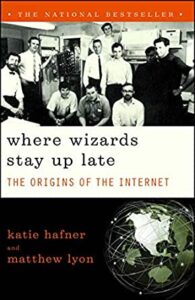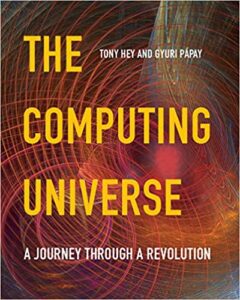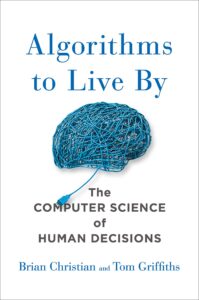
As we notch up another day from the depths of quarantine, the simple and sometimes forgotten pleasure of reading is a great way to take a break from Zoom meetings, the daily cauldron of bad news on TV, or the family. As Dave Barry observed, reading is "a vacation for the mind," and we can certainly all use a break right about now. Here are some tech-related ideas for your summer reading pleasure!

"The book, almost certainly destined to be the definitive work on the birth and early years of the Internet, is sweeping in scope....Whoever chooses to write the next chapter in the saga . . . has a tough act to follow."
—David Plotnikoff, San Jose Mercury News
Twenty five years ago, it didn't exist. Today, twenty million people worldwide are surfing the Net. Where Wizards Stay Up Late is the exciting story of the pioneers responsible for creating the most talked about, most influential, and most far-reaching communications breakthrough since the invention of the telephone.
In the 1960s, when computers where regarded as mere giant calculators, J.C.R. Licklider at MIT saw them as the ultimate communications devices. With Defense Department funds, he and a band of visionary computer whizzes began work on a nationwide, interlocking network of computers. Taking readers behind the scenes, Where Wizards Stay Up Late captures the hard work, genius, and happy accidents of their daring, stunningly successful venture.

"Read this book. A treat for anyone with even a passing interest in the origins of today's siliconized culture."
—Business Week
In the bestselling tradition of The Soul of a New Machine, Dealers of Lightning is a fascinating journey of intellectual creation. In the 1970s and '80s, Xerox Corporation brought together a brain-trust of engineering geniuses, a group of computer eccentrics dubbed PARC. This brilliant group created several monumental innovations that triggered a technological revolution, including the first personal computer, the laser printer, and the graphical interface (one of the main precursors of the Internet), only to see these breakthroughs rejected by the corporation. Yet, instead of giving up, these determined inventors turned their ideas into empires that radically altered contemporary life and changed the world.
Based on extensive interviews with the scientists, engineers, administrators, and executives who lived the story, this riveting chronicle details PARC's humble beginnings through its triumph as a hothouse for ideas, and shows why Xerox was never able to grasp, and ultimately exploit, the cutting-edge innovations PARC delivered. Dealers of Lightning offers an unprecedented look at the ideas, the inventions, and the individuals that propelled Xerox PARC to the frontier of technohistory—and the corporate machinations that almost prevented it from achieving greatness.

"The stories Adam Fisher weaves together in VALLEY OF GENIUS alone make the book a fascinating read: tales of heroic innovation, risk and reward, boom and bust cycles. But Fisher achieves something even more important with this 'autobiography' of Silicon Valley: an understanding of how momentous technological changes in society come about, and how they can sometimes surprise even their creators with their broader impact."
―Steven Johnson, bestselling author of How We Got to Now
Rarely has one economy asserted itself as swiftly—and as aggressively—as the entity we now know as Silicon Valley. Built with a seemingly permanent culture of reinvention, Silicon Valley does not fight change; it embraces it, and now powers the American economy and global innovation.
So how did this omnipotent and ever-morphing place come to be? It was not by planning. It was, like many an empire before it, part luck, part timing, and part ambition. And part pure, unbridled genius . . .
Drawing on over two hundred in-depth interviews, Valley of Genius takes readers from the dawn of the personal computer and the internet, through the heyday of the web, up to the very moment when our current technological reality was invented. It interweaves accounts of invention and betrayal, overnight success and underground exploits, to tell the story of Silicon Valley like it has never been told before. Read it to discover the stories that Valley insiders tell each other: the tall tales that are all, improbably, true.

"Bad Blood is the real be-all end-all of Theranos information…. Bad Blood is wild, and more happens on one page than in many other entire books."
—Margaret Lyons, New York Times
In 2014, Theranos founder and CEO Elizabeth Holmes was widely seen as the female Steve Jobs: a brilliant Stanford dropout whose startup “unicorn” promised to revolutionize the medical industry with a machine that would make blood testing significantly faster and easier. Backed by investors such as Larry Ellison and Tim Draper, Theranos sold shares in a fundraising round that valued the company at more than $9 billion, putting Holmes’s worth at an estimated $4.7 billion. There was just one problem: The technology didn’t work.
A riveting story of the biggest corporate fraud since Enron, a tale of ambition and hubris set amid the bold promises of Silicon Valley.

"In his newest book, Architects of Intelligence, Martin Ford provides us with an invaluable opportunity to learn from some of the most prominent thought leaders about the emerging fields of science that are shaping our future."
—Al Gore, Former Vice President of the US
How will AI evolve and what major innovations are on the horizon? What will its impact be on the job market, economy, and society? What is the path toward human-level machine intelligence? What should we be concerned about as artificial intelligence advances?
Architects of Intelligence contains a series of in-depth, one-to-one interviews where New York Times bestselling author, Martin Ford, uncovers the truth behind these questions from some of the brightest minds in the Artificial Intelligence community.

“Levy’s all-access Facebook reflects the reputational swan dive of its subject. . . . The result is evenhanded and devastating.”
—San Francisco Chronicle
As a college sophomore, Mark Zuckerberg created a simple website to serve as a campus social network.
Today, Facebook is nearly unrecognizable from its first, modest iteration. In light of recent controversies surrounding election-influencing “fake news” accounts, the handling of its users’ personal data, and growing discontent with the actions of its founder and CEO—who has enormous power over what the world sees and says—never has a company been more central to the national conversation.
Millions of words have been written about Facebook, but no one has told the complete story, documenting its ascendancy and missteps. There is no denying the power and omnipresence of Facebook in American daily life, or the imperative of this book to document the unchecked power and shocking techniques of the company, from growing at all costs to outmaneuvering its biggest rivals to acquire WhatsApp and Instagram to developing a platform so addictive even some of its own are now beginning to realize its dangers.
Based on hundreds of interviews inside and outside the company, Levy’s sweeping narrative of incredible entrepreneurial success and failure digs deep into the whole story of the company that has changed the world and reaped the consequences.

"Tony Hey has made significant contributions to both physics and computer science and with The Computing Universe he and his co-author share the knowledge and history that has inspired us all."
—Bill Gates
Computers now impact almost every aspect of our lives, from our social interactions to the safety and performance of our cars. How did this happen in such a short time? And this is just the beginning. . . . In this book, Tony Hey and Gyuri Pápay lead us on a journey from the early days of computers in the 1930s to the cutting-edge research of the present day that will shape computing in the coming decades. Along the way, they explain the ideas behind hardware, software, algorithms, Moore's Law, the birth of the personal computer, the Internet and the Web, the Turing Test, Jeopardy's Watson, World of Warcraft, spyware, Google, Facebook, and quantum computing. This book also introduces the fascinating cast of dreamers and inventors who brought these great technological developments into every corner of the modern world. This exciting and accessible introduction will open up the universe of computing to anyone who has ever wondered where his or her smartphone came from.

“Meticulous . . . the depth and detail that are the book’s strength make it an effective, fact-based rudder with which would-be scientists and their allies can stabilize their flights of fancy. This hardworking, earnest book is the perfect foil for the glamour still to come.”
—Seattle Times
Before John Glenn orbited the earth, or Neil Armstrong walked on the moon, a group of dedicated female mathematicians known as “human computers” used pencils, slide rules and adding machines to calculate the numbers that would launch rockets, and astronauts, into space.
Among these problem-solvers were a group of exceptionally talented African American women, some of the brightest minds of their generation. Originally relegated to teaching math in the South’s segregated public schools, they were called into service during the labor shortages of World War II, when America’s aeronautics industry was in dire need of anyone who had the right stuff. Suddenly, these overlooked math whizzes had a shot at jobs worthy of their skills, and they answered Uncle Sam’s call, moving to Hampton, Virginia and the fascinating, high-energy world of the Langley Memorial Aeronautical Laboratory.
Even as Virginia’s Jim Crow laws required them to be segregated from their white counterparts, the women of Langley’s all-black “West Computing” group helped America achieve one of the things it desired most: a decisive victory over the Soviet Union in the Cold War, and complete domination of the heavens.
Starting in World War II and moving through to the Cold War, the Civil Rights Movement and the Space Race, Hidden Figures follows the interwoven accounts of Dorothy Vaughan, Mary Jackson, Katherine Johnson and Christine Darden, four African American women who participated in some of NASA’s greatest successes. It chronicles their careers over nearly three decades they faced challenges, forged alliances and used their intellect to change their own lives, and their country’s future.

“Immensely readable . . . A hair-raising, cautionary tale about the burgeoning, post-Stuxnet world of state-sponsored hackers.”
—Washington Post
In 2014, the world witnessed the start of a mysterious series of cyberattacks. Targeting American utility companies, NATO, and electric grids in Eastern Europe, the strikes grew ever more brazen. They culminated in the summer of 2017, when the malware known as NotPetya was unleashed, penetrating, disrupting, and paralyzing some of the world's largest businesses—from drug manufacturers to software developers to shipping companies. At the attack's epicenter in Ukraine, ATMs froze. The railway and postal systems shut down. Hospitals went dark. NotPetya spread around the world, inflicting an unprecedented ten billion dollars in damage—the largest, most destructive cyberattack the world had ever seen.
The hackers behind these attacks are quickly gaining a reputation as the most dangerous team of cyberwarriors in history: a group known as Sandworm. Working in the service of Russia's military intelligence agency, they represent a persistent, highly skilled force, one whose talents are matched by their willingness to launch broad, unrestrained attacks on the most critical infrastructure of their adversaries. They target government and private sector, military and civilians alike.
A chilling, globe-spanning detective story, Sandworm considers the danger this force poses to our national security and stability. As the Kremlin's role in foreign government manipulation comes into greater focus, Sandworm exposes the realities not just of Russia's global digital offensive, but of an era where warfare ceases to be waged on the battlefield. It reveals how the lines between digital and physical conflict, between wartime and peacetime, have begun to blur—with world-shaking implications.

“A remarkable book . . . A solid, research-based book that’s applicable to real life. The algorithms the authors discuss are, in fact, more applicable to real-life problems than I’d have ever predicted. . . . It’s well worth the time to find a copy of Algorithms to Live By and dig deeper.”
―Forbes
All our lives are constrained by limited space and time, limits that give rise to a particular set of problems. What should we do, or leave undone, in a day or a lifetime? How much messiness should we accept? What balance of new activities and familiar favorites is the most fulfilling? These may seem like uniquely human quandaries, but they are not: computers, too, face the same constraints, so computer scientists have been grappling with their version of such issues for decades. And the solutions they've found have much to teach us.
In a dazzlingly interdisciplinary work, acclaimed author Brian Christian and cognitive scientist Tom Griffiths show how the algorithms used by computers can also untangle very human questions. They explain how to have better hunches and when to leave things to chance, how to deal with overwhelming choices and how best to connect with others. From finding a spouse to finding a parking spot, from organizing one's inbox to understanding the workings of memory, Algorithms to Live By transforms the wisdom of computer science into strategies for human living.